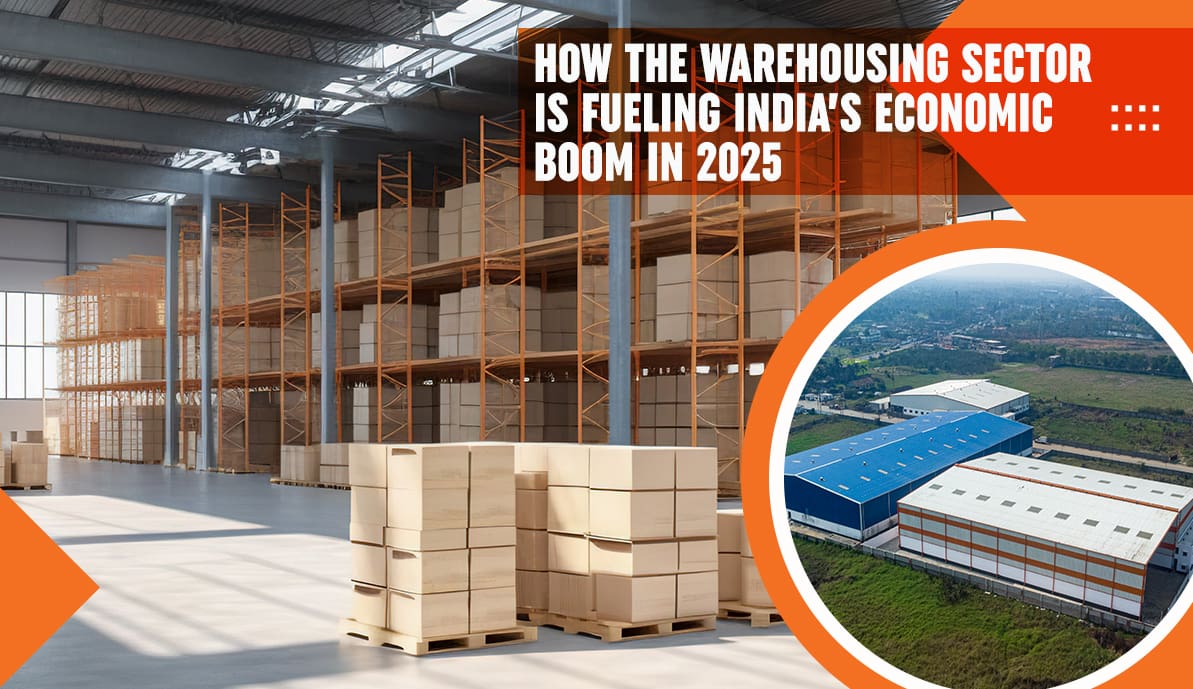India’s warehousing sector has experienced excellent transformation in recent years. From outdated godowns to modern, technologically advanced hubs, warehouses are now at the heart of the country’s logistics and supply chain networks. Modern amenities support automation, temperature control, and excellent inventory management. The state-of-the-art facilities have brought drastic change in how goods move across India.
As e-commerce, manufacturing, and infrastructure continue to expand rapidly in 2025, the warehousing sector plays a vital role in propelling India’s economic growth. The major shift brings in maximum potential for investment, specifically in the warehousing hub in the Howrah-Kolkata region.
Key Drivers of Growth
-
E-commerce Expansion
The rise of e-commerce and e-shopping continues to fuel demand for warehousing across the country. E-commerce revenues are growing at over 30% annually, and India is expected to surpass the US in the number of online shoppers within the next one to two years. Quick deliveries and high service expectations have encouraged brands to invest in regional and hyperlocal distribution centres and modern warehousing facilities more than ever.
- Manufacturing Surge
India’s manufacturing sector is growing robustly, boosted by initiatives like “Make in India,” Production Linked Incentive (PLI) schemes, and the China-plus-one strategy. The trends have led to high demand for warehousing of raw materials and manufactured products.
- Development in Infrastructure
Government investments in highways, freight corridors, and commercial parks have significantly enhanced transport efficiency. These improvements have not only connected rural and urban markets more effectively but also attracted private investment into warehousing developments in key regions, including Kolkata and Howrah, with warehouse providers like Ganesh Complex.
- Cold Chain and Specialised Storage Facilities
The demand for cold storage facilities, especially in business segments like dairy, pharmaceuticals, and processed food items, is increasing with time. Cold chain infrastructure, to be specific, plays a key role in keeping the quality and safety of perishable items. The facility further expands the warehousing needs among industries.
Market Overview
India’s warehousing market was valued at approximately ₹1.2 lakh crore in 2021. The market is expected to grow at a compound annual growth rate (CAGR) of 15.5 %, which will reach around ₹2.9 lakh crore by 2027. This growth surpasses the broader logistics sector, underlining warehousing’s central role in the supply chain.
India has enough scope to expand further. The per capita warehousing space in India stands at only 0.02 square meters, compared to 4.4 square meters in the US. This gap demonstrates the huge opportunity for both public and private investment.
Warehousing in Kolkata
Kolkata, traditionally a trade and logistics hub, is witnessing renewed interest in Commercial Properties Kolkata. Ganesh Complex offers large-scale facilities with modern infrastructure, strategic location benefits, and proximity to transport corridors, making it attractive for investors and occupiers alike.
With around 19 to 20% of warehousing space in Kolkata still vacant, there is strong potential for redevelopment and investment in Grade A warehouses that meet international standards.
Demand Segmentation
- Third-party logistics (3PL) companies and e-commerce players account for approximately 39 per cent of the total warehousing stock. These businesses depend on flexible, scalable, and high-efficiency storage solutions to meet dynamic market demands.
- Manufacturing industries have become significant occupiers, accounting for about 30 percent of total space, especially with the resurgence of domestic production.
- Retail and organised commerce, driven by increased consumption in big cities, shows approximately 13% of the total demand. Mostly Tier 2 and Tier 3 cities come under the overview.
- Consumer goods and telecom contribute modestly but consistently. It takes around 3 to 5% of the warehousing footprint.
Trends and Transaction Volumes
Despite initial concerns about a slowdown in e-commerce after the pandemic, warehousing transaction volumes remained steady in FY23, matching record highs of FY22. Approximately 4.8 million square meters of transactions were recorded, with increased activity from the manufacturing sector helping fill any shortfalls from e-commerce.
Tier 2 and Tier 3 cities are becoming hotspots for warehousing development. Brands are distributing their inventory closer to customers to enable faster delivery and reduce logistics costs. The consistently growing demand is creating a new wave of growth in non-metro cities.
Focus on Grade A Warehousing
The industry is steadily shifting from older, unorganised godowns to structured, grade A warehouses. These modern facilities offer:
- Enhanced floor load capacity
- Automated and optimised layout designs
- Safety features and compliance with global standards
- Better operational efficiency and energy management
To meet the growing demand for warehousing space, India is projected to require nearly 223 million square feet of additional Grade A warehousing space over the next three years.
Investment Outlook
India’s warehousing sector is among the top choices for real estate and infrastructure investment. In 2022 alone, private equity investors poured approximately USD 1.9 billion into the industry, despite broader market headwinds.
To develop the warehousing infrastructure necessary to meet future demand, an estimated USD 3.8 billion in investment is required. So far, only around USD 1 billion has been deployed, leaving a latent investment gap of USD 2.8 billion.
The high transaction volumes and steady rise in capital flow demonstrate that investors see long-term value in India’s logistics infrastructure.
Ganesh Complex: Take A Strategic Advantage
Ganesh Complex in Kolkata leads to the next generation of industrial and warehousing parks. Located with excellent road and port connectivity, it offers scalable solutions for 3PL providers, FMCG brands, and manufacturing units.
With high-grade infrastructure and ample space for expansion, Ganesh Complex is ideally suited for:
- E-commerce fulfilment centres
- Regional distribution hubs
- Cold storage facilities
- Manufacturing storage spaces
Its proximity to Kolkata’s key transport corridors gives it a competitive advantage for last-mile delivery and inter-state distribution.
Future Trends
In the coming time, several factors will shape the future of warehousing in India:
- Hyper-local and decentralised inventory management will increase the demand for regional hubs.
- Sustainable warehouses equipped with solar energy, water recycling, and green certifications will gain prominence.
- Automation and AI integration will enhance inventory tracking, order picking, and predictive stocking.
- Cold chain logistics will see significant investment, particularly in the food, vaccine, and pharmaceutical industries.
Concluding thoughts
Warehousing sectors are now more than just business support facilities. They have become the driving force behind India’s economic growth. With rising consumer expectations, manufacturing output, and wide infrastructure upgrades, modern warehousing ensures high-growth and high-opportunities. Kolkata-Howrah region, with prime hubs like Ganesh Complex plays a pivotal role in change.
Whether you are seeking for commercial properties in Kolkata or a warehouse for sale in Kolkata, the warehousing landscape in 2025 is a powerful mix of opportunity, scalability, and strategic relevance. For investors, developers, and occupiers alike, now is the best time to explore and capitalise on India’s warehousing revolution.









